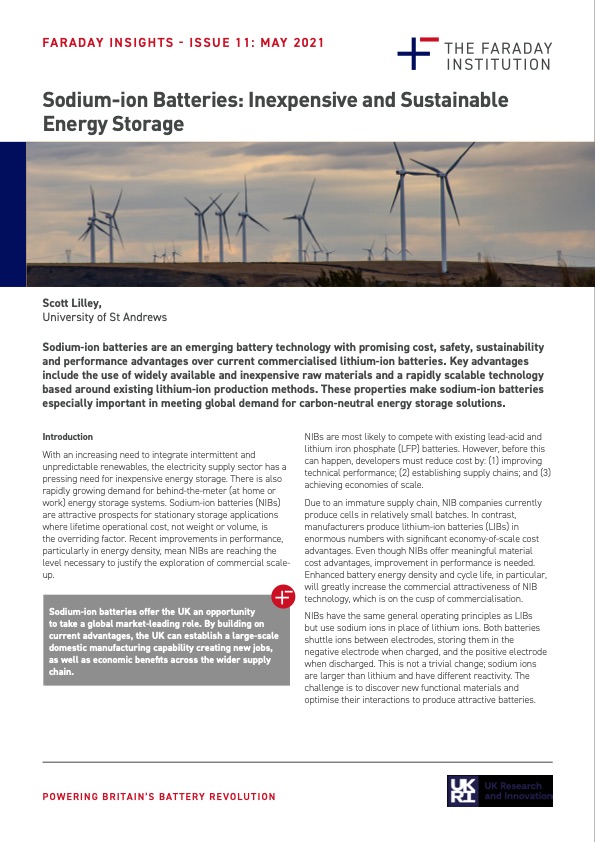
PDF Publication Title:
Text from PDF Page: 001
FARADAY INSIGHTS - ISSUE 11: MAY 2021 Sodium-ion Batteries: Inexpensive and Sustainable Energy Storage Scott Lilley, University of St Andrews Sodium-ion batteries are an emerging battery technology with promising cost, safety, sustainability and performance advantages over current commercialised lithium-ion batteries. Key advantages include the use of widely available and inexpensive raw materials and a rapidly scalable technology based around existing lithium-ion production methods. These properties make sodium-ion batteries especially important in meeting global demand for carbon-neutral energy storage solutions. Introduction With an increasing need to integrate intermittent and unpredictable renewables, the electricity supply sector has a pressing need for inexpensive energy storage. There is also rapidly growing demand for behind-the-meter (at home or work) energy storage systems. Sodium-ion batteries (NIBs) are attractive prospects for stationary storage applications where lifetime operational cost, not weight or volume, is the overriding factor. Recent improvements in performance, particularly in energy density, mean NIBs are reaching the level necessary to justify the exploration of commercial scale- up. NIBs are most likely to compete with existing lead-acid and lithium iron phosphate (LFP) batteries. However, before this can happen, developers must reduce cost by: (1) improving technical performance; (2) establishing supply chains; and (3) achieving economies of scale. Due to an immature supply chain, NIB companies currently produce cells in relatively small batches. In contrast, manufacturers produce lithium-ion batteries (LIBs) in enormous numbers with significant economy-of-scale cost advantages. Even though NIBs offer meaningful material cost advantages, improvement in performance is needed. Enhanced battery energy density and cycle life, in particular, will greatly increase the commercial attractiveness of NIB technology, which is on the cusp of commercialisation. NIBs have the same general operating principles as LIBs but use sodium ions in place of lithium ions. Both batteries shuttle ions between electrodes, storing them in the negative electrode when charged, and the positive electrode when discharged. This is not a trivial change; sodium ions are larger than lithium and have different reactivity. The challenge is to discover new functional materials and optimise their interactions to produce attractive batteries. Sodium-ion batteries offer the UK an opportunity to take a global market-leading role. By building on current advantages, the UK can establish a large-scale domestic manufacturing capability creating new jobs, as well as economic benefits across the wider supply chain. POWERING BRITAIN’S BATTERY REVOLUTIONPDF Image | Sodium-ion Batteries: Inexpensive and Sustainable Storage

PDF Search Title:
Sodium-ion Batteries: Inexpensive and Sustainable StorageOriginal File Name Searched:
Faraday_Insights_11_FINAL.pdfDIY PDF Search: Google It | Yahoo | Bing
Salgenx Redox Flow Battery Technology: Salt water flow battery technology with low cost and great energy density that can be used for power storage and thermal storage. Let us de-risk your production using our license. Our aqueous flow battery is less cost than Tesla Megapack and available faster. Redox flow battery. No membrane needed like with Vanadium, or Bromine. Salgenx flow battery
| CONTACT TEL: 608-238-6001 Email: greg@salgenx.com | RSS | AMP |